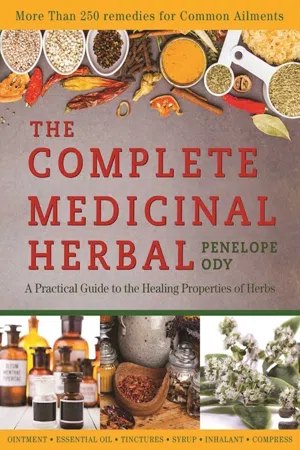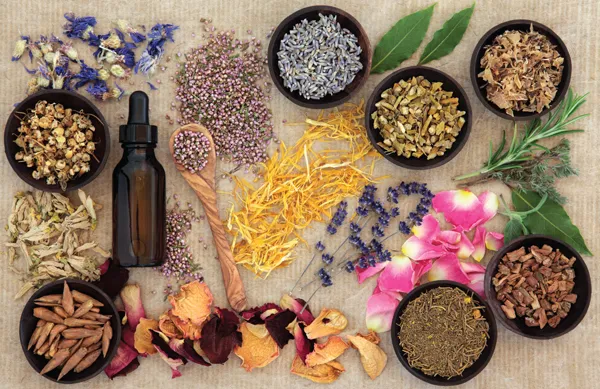![]()
A–Z OF MEDICINAL HERBS
This index includes a representative selection of the many thousands of plants with medicinal properties and shows the range of herbal remedies available. Each entry gives details of the parts used, actions, active ingredients, and “character” based on traditional Western, Chinese, or Ayurvedic classification. There are also suggested applications: before using these, refer to the ailment-by-ailment guides in Home Remedies (p. 152) or to Other Medicinal Herbs (p. 253). All preparations and dosages are standard (pp. 142–147) unless otherwise specified. Do not take essential oils internally unless directed by a heath care professional.
![]()
AYURVEDIC HERBS
OUT OF INDIA
The Ayurvedic healing tradition in India dates back to the Rigveda, written between 3500 and 1800 B.C. Later theories have also influenced the therapeutic uses of the many thousands of medicinal herbs used in the subcontinent. The Siddha system, which attains spiritual perfection through meditation, for example, started around 2000 B.C. among the Dravidian people of Southern India and was believed to originate directly from the Hindu deity Shiva and his wife, Parvati. Later Arab traders brought the Unani-Tibb tradition (based on ancient Greek theories), which was a favorite with the Moghul emperors from the fourteenth century. Many plants are common to all three systems, but there can often be subtle differences, which can make interpretation of Indian plant therapeutics more complex. India’s many different languages also mean that the same plant can be known by a dozen different names.
Around 75% of India’s population still depend on traditional medicines, which significantly outsell conventional drugs. Many products are complex, and adulteration is all too common; for example, “ashtavarga” used as a fertility tonic, should be made of eight herbs, most of them from the lily family, but analysis has shown at least 42 different plants in samples. Many prepared remedies also contain heavy metals and gemstones and are often regarded suspiciously by Western medicines regulators.
Santalum album – chandana, sandalwood
Traditionally, sandalwood (chandana) is used to cool and calm the body and mind, awaken the intelligence, and open the third eye to increase devotion and meditation. Aromatherapists combine it with rose, neroli, or benzoin oils as a calming, sedative, and antidepressant massage. The wood is used in decoctions for fevers and inflammations and as a circulatory and digestive stimulant. It is known as tan xiang in China and is believed to normalize energy flows to the stomach and spleen, to stimulate the digestion and relieve pain.
Parts used: Inner heartwood, volatile oil.
Key uses: Sandalwood is strongly antiseptic and antibacterial and can be used as a wash or made into a paste for external sores. The oil is used in massage for urinary problems, including cystitis, and digestive upsets with abdominal discomfort. It can be added to warm compresses for dry skin, itching, and irritation, and also added to rosewater as a lotion for acne. A few drops to the brow chakra (third eye) can improve concentration and cool the body in fevers and thirst.
Cautions: Do not take the essential oil internally.
Cinnamomum camphora – camphor, karpura
In Ayurvedic medicine camphor (karpura) is used to open the senses, clear the mind, and help mediation. In India, a pinch of powdered camphor is taken as snuff for nasal congestion and headaches and in infusion for a range of respiratory problems and emotional upsets. It is not used internally in the West since it is known to contain safrole, which is carcinogenic. Instead it is used in medicated oils traditionally used for chest rubs and muscular aches and pains.
Parts used: Crystalized distilled oil.
Key uses: In the West, camphorated oils are used externally for coughs, influenza, bronchitis and breathing difficulties. In aromatherapy, it is used to stimulate heart and respiration and to raise low blood pressure. It can also help balance the nervous system – stimulating in depression and calming in hysteria. A compress soaked in weak camphor infusion can relieve backache, and it is used in lotions for cold sores and chilblains. Camphorated oil can be made by dissolving 25 g of camphor crystals in 500 ml of sesame oil.
Cautions: Do not take camphor internally and use only pure raw camphor, not synthetic substitutes.
Commiphora mukul – guggul/guggula
A close relative of myrrh, guggul (guggula) is purifying and rejuvenating and forms the basis of a series of Ayurvedic remedies known as gugguls. Traditionally it was used as a remedy for arthritis and applied externally in plasters for aches and pains. Like myrrh it is also added to gargles and mouthwashes for sore throats and mouth ulcers. Research suggests that guggul will also reduce high blood cholesterol levels – studies suggested by ancient Sanskrit texts which recommended the herb for treating obesity and lipid disorders.
Parts used: Oleo-gum-resin.
Key uses: In India guggul is combined with herbs such as gokshura (Tribulis terrestris) and the trikatu combination for urinary problems or with triphala and pippali for ulcers and arthritic conditions. The herb is also anti-inflammatory, stimulates white blood cell production, reduces blood clotting, and helps protect heart tissue in degenerative diseases. In the West, extracts are starting to be used to reduce cholesterol.
Cautions: Avoid in pregnancy and breastfeeding.
Picrorrhiza kurroa – katuka
Katuka is an important bitter digestive remedy used in India to stimulate the digestion, improve appetite, and treat jaundice, diarrhea, and constipation. Modern research has confirmed that it acts to protect the liver from a variety of toxins and in some studies has proved more effective than silymarin from milk thistle. It is the main ingredient in arogyavardhini – a complex remedy used for liver d...

